The archives collection chronicles the organization and activities of the Society of the Cincinnati from its founding in 1783 to the present. The early documents, covering the period from 1783 through the early 1930s, are accessible to researchers and provide a wealth of information on the history of the Society and related topics in American history, such as compensation for Revolutionary War veterans and widows, public views of military officers and hereditary organizations, early French-American relations, and nineteenth- and twentieth-century remembrances of the Revolutionary War. Highlights of the historical archives include the original Institution of the Society, early minute books, and manuscript correspondence of prominent original members such as George Washington, Henry Knox, and Pierre L’Enfant. The archives also include L’Enfant’s original drawings for the Society’s emblems of membership and the original copper plate used for printing the Society diploma he designed. More modern materials in the archives include records from the late nineteenth century through the present regarding the Society’s activities, such as minutes, correspondence, rosters, programs, menus, and photographs of Society events.
From its earliest meetings, the Society took great care in organizing its official records, commissioning a special mahogany box in 1787 to house and protect them. For more than a century, the growing archives collection was kept in the personal custody of the Society’s secretary general, moving from house to house until 1911, when the Society arranged to have the collection housed with the Lincoln Safe Deposit and Storage Company in New York City. In 1930, the archives were placed on deposit at the Library of Congress, where they were made available to researchers and microfilmed. After the establishment of the library in the Society’s headquarters at Anderson House, the archives were returned to the Society’s care in 1973.
The early archival collection is described in a finding aid on the digital library.
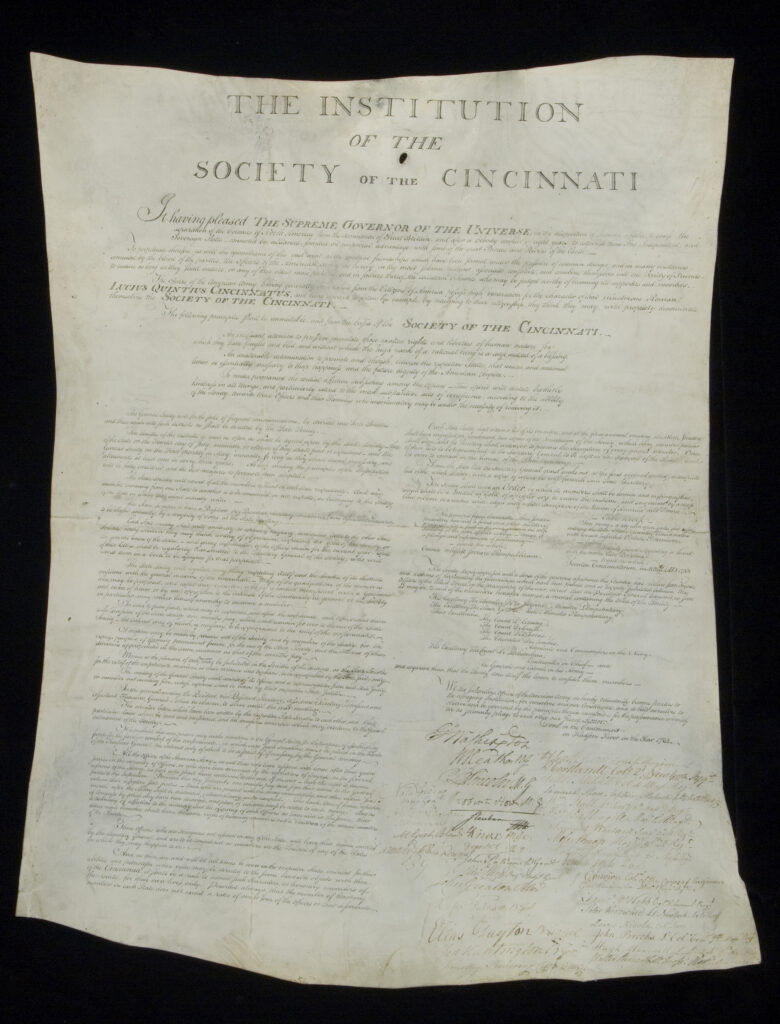
May 1783
The Society of the Cincinnati Archives
Adopted at the founding meeting on May 13, 1783, the Institution remains the principle guiding document of the organization to the present day. The first official copy was inscribed on a large, irregularly shaped sheet of parchment and signed by George Washington and thirty-five other officers. The Institution lays out the tenets and organizational structure of the Society, the rules of eligibility to membership, the establishment of constituent branches, and details of the Society’s insignia. To join the Society, the original members were required to sign their names to the Institution, thus pledging their allegiance to the immutable principles upon which the Society was founded.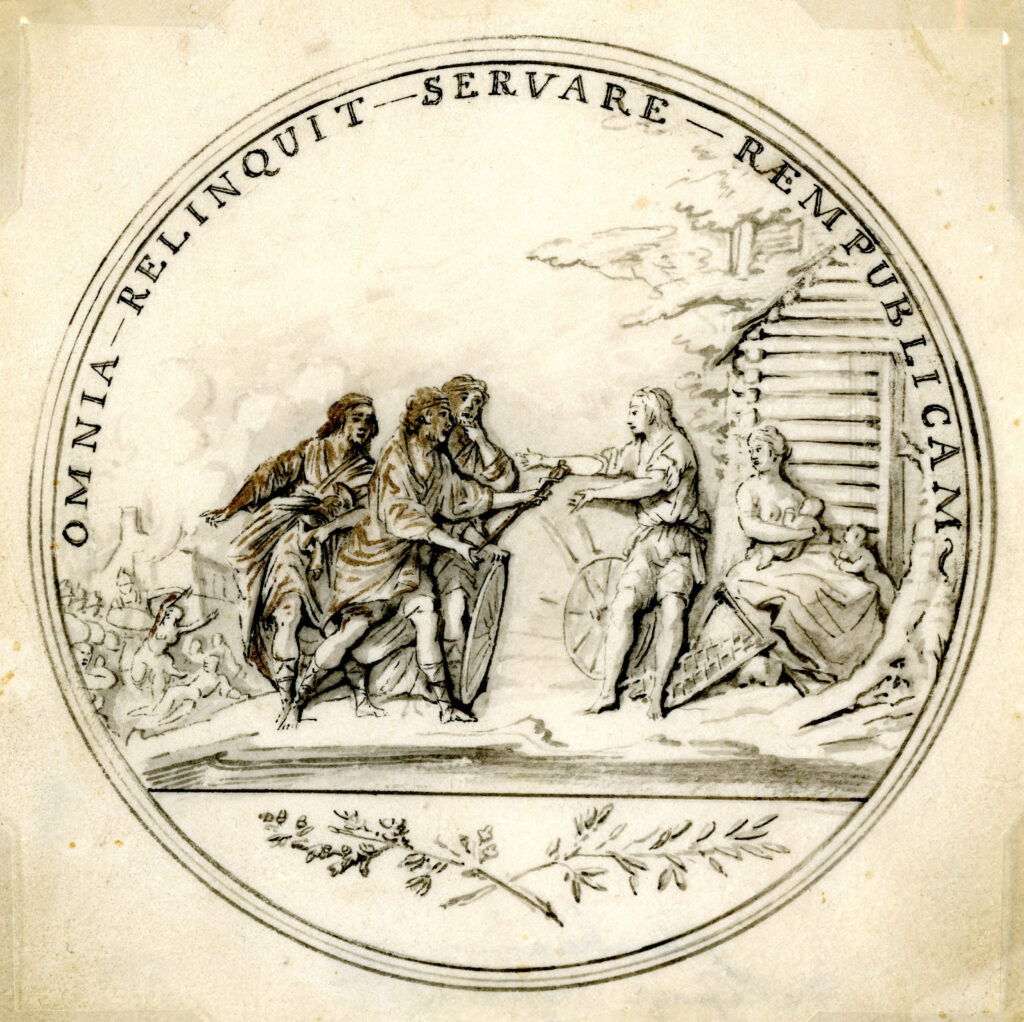
Pierre-Charles L’Enfant
June 1783
The Society of the Cincinnati Archives
At the request of the Society, Pierre-Charles L’Enfant, a French volunteer in the Continental Army Corps of Engineers, drew a design for a medal bearing imagery of the life of the fifth-century BC Roman hero Cincinnatus, from whom the Society takes its name. The obverse, shown here, depicts Cincinnatus receiving his sword from Roman senators as he leaves home to lead his country against its enemies.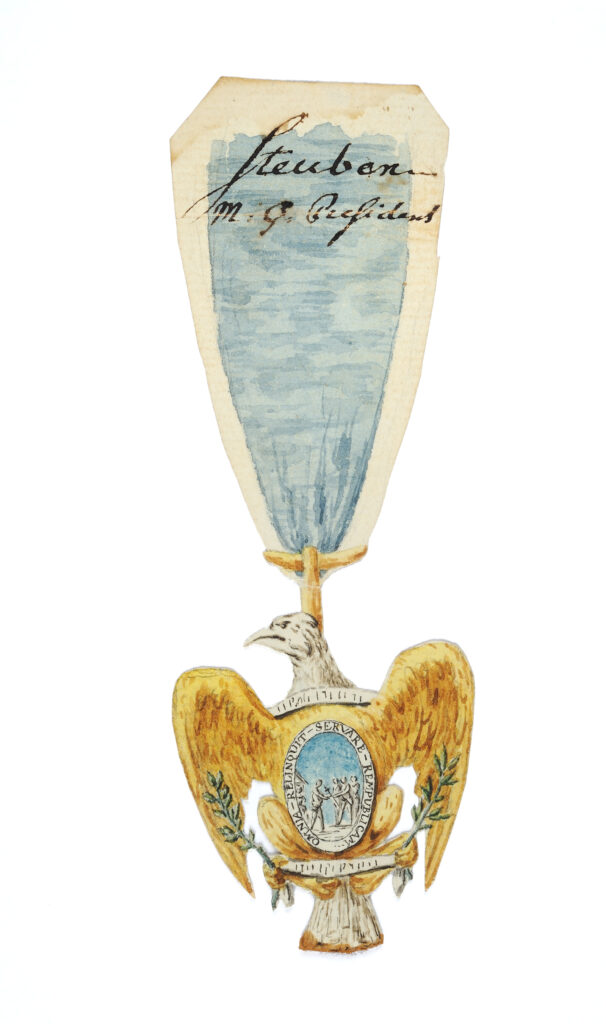
Pierre-Charles L’Enfant
June 1783
The Society of the Cincinnati Archives
This cutout of the design for a badge in the form of a bald eagle suspended by a blue-and-white ribbon was submitted by L’Enfant as an alternative to the medal described in the Institution. In June 1783, the Society adopted the Eagle as its official insignia. General Steuben, acting as president pro-tem of the Society, boldly signed his name across the top of the ribbon, consigning this original watercolor drawing to the archives. L’Enfant made additional copies of the Eagle design, which were circulated among the state branches to encourage orders.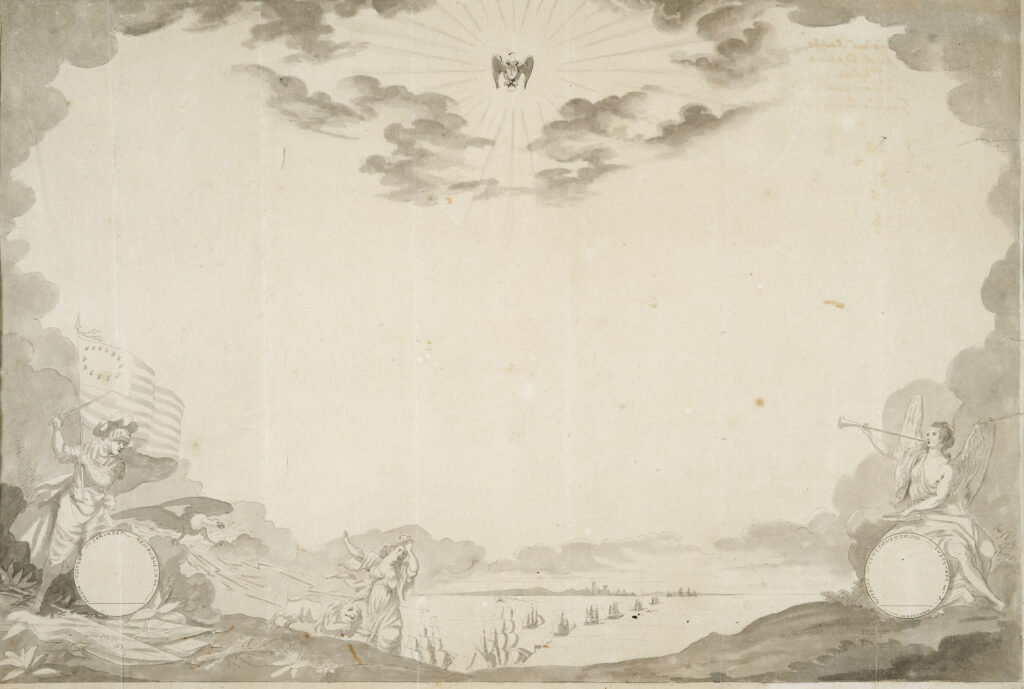
Pierre-Charles L’Enfant
June 1783
The Society of the Cincinnati Archives
Concerned that all members of the Society might not be able to afford to purchase an Eagle, L’Enfant also submitted this design for an elegant membership certificate, to be called the diploma. The imagery depicts America forcing Britannia away from its shores, with Fame heralding the achievement of American independence. The Society adopted the diploma and the Eagle as the official emblems of membership at its June 19, 1783, meeting.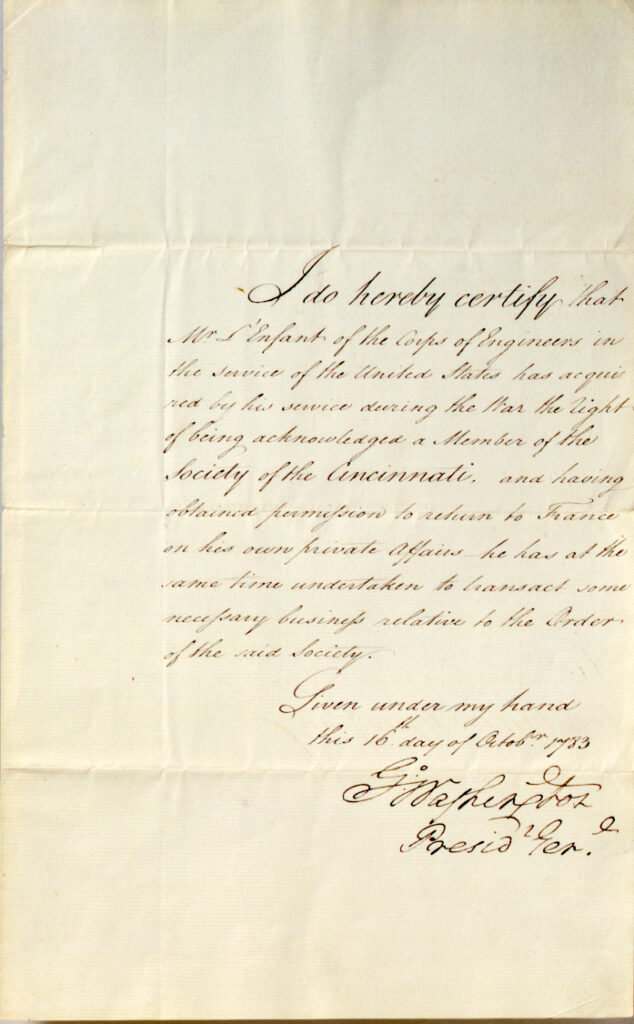
George Washington
October 16, 1783
The Society of the Cincinnati Archives
In the fall of 1783, L’Enfant traveled to Paris to oversee the production of the first gold Eagles and the engraving of a copperplate for the diploma. This certificate, signed by George Washington as president general, states that L’Enfant is a member of the Society and is authorized to “transact some necessary business relative to the Order” while in France.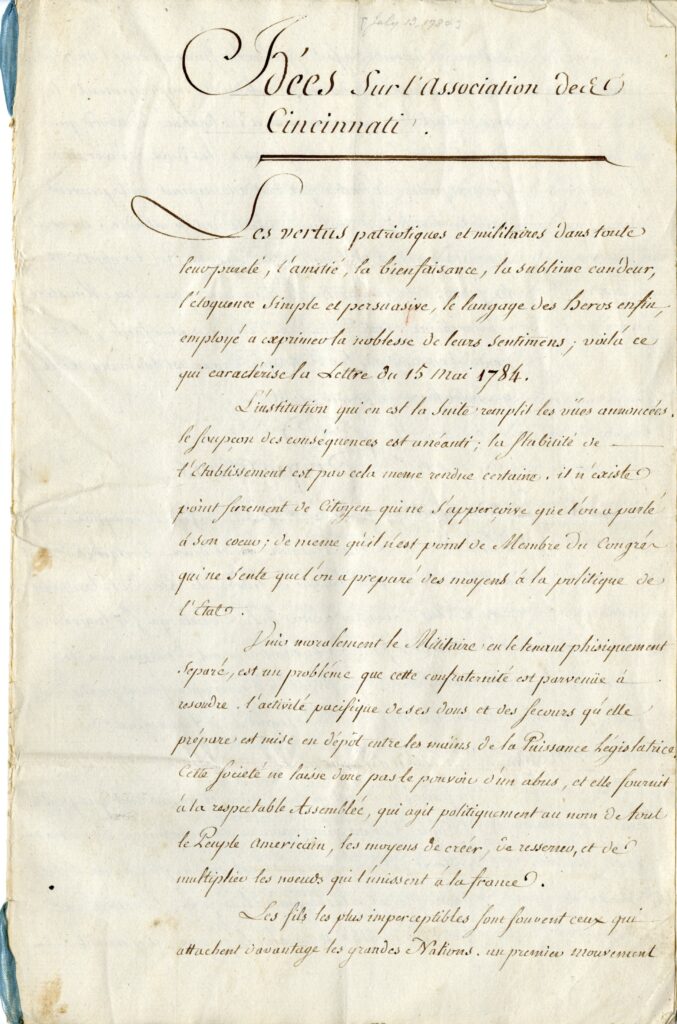
Charles Henri, comte d’Estaing
July 13, 1784
The Society of the Cincinnati Archives
Admiral d’Estaing, who served as the first president of the Société des Cincinnati de France, wrote a twelve-page essay in response to the amendments to the Society’s Institution proposed at the first general meeting held in May 1784. In addition to recommending a special structure of officers for the French branch (two vice presidents, one from the army and one from the navy), he suggested that women who have demonstrated their zeal for the American cause by supporting their husbands and fathers also be eligible to wear the Eagle of the Society.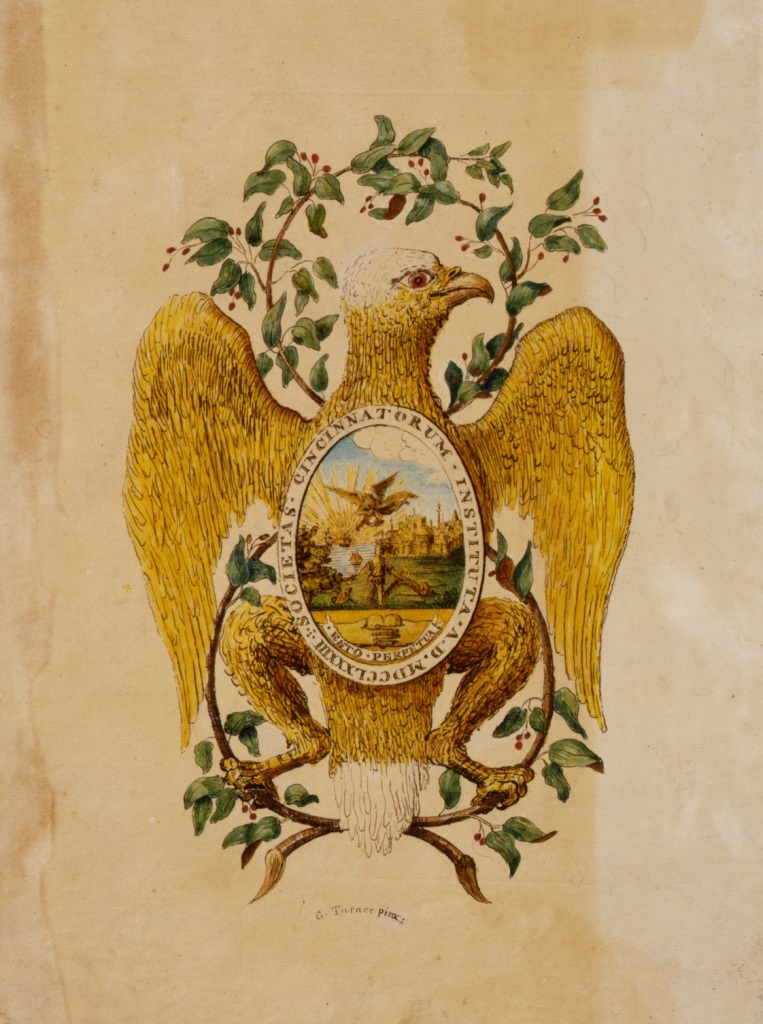
George Turner
1784-1787
The Society of the Cincinnati Archives
The minute book of proceedings of the Society’s earliest meetings was kept by Assistant Secretary General George Turner, who drew an elaborate rendering of the Society’s Eagle on its front paste-down end paper. Turner, a captain in the First South Carolina Regiment, settled in Philadelphia after the war and took an active role in gathering and organizing the Society’s papers during its first decade. He later served as a judge in the Northwest Territory.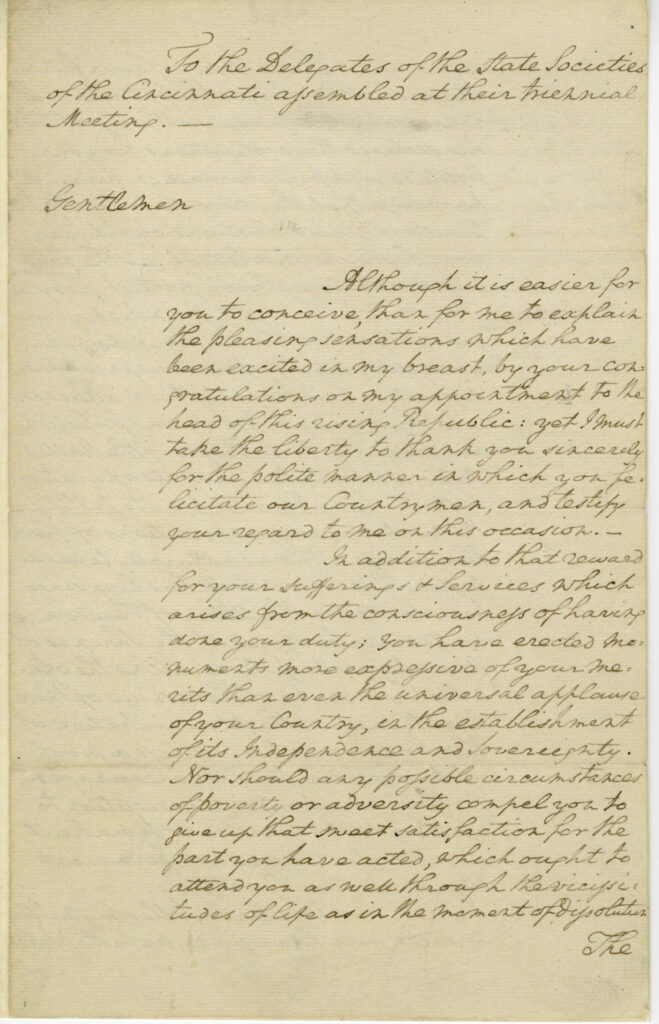
May 1790
The Society of the Cincinnati Archives
In his message to the delegates to the 1790 Triennial Meeting, Washington recognized that much of the public’s early concerns about the Society as an elitist or political force seemed to have been defused: “The candor of your fellow-citizens acknowledges the patriotism of your conduct in peace, as their gratitude has declared their obligations for your fortitude and perseverance in war. A knowledge that they now do justice to the purity of your intentions ought to be your highest consolation, as the fact is demonstrative of your greatest glory.”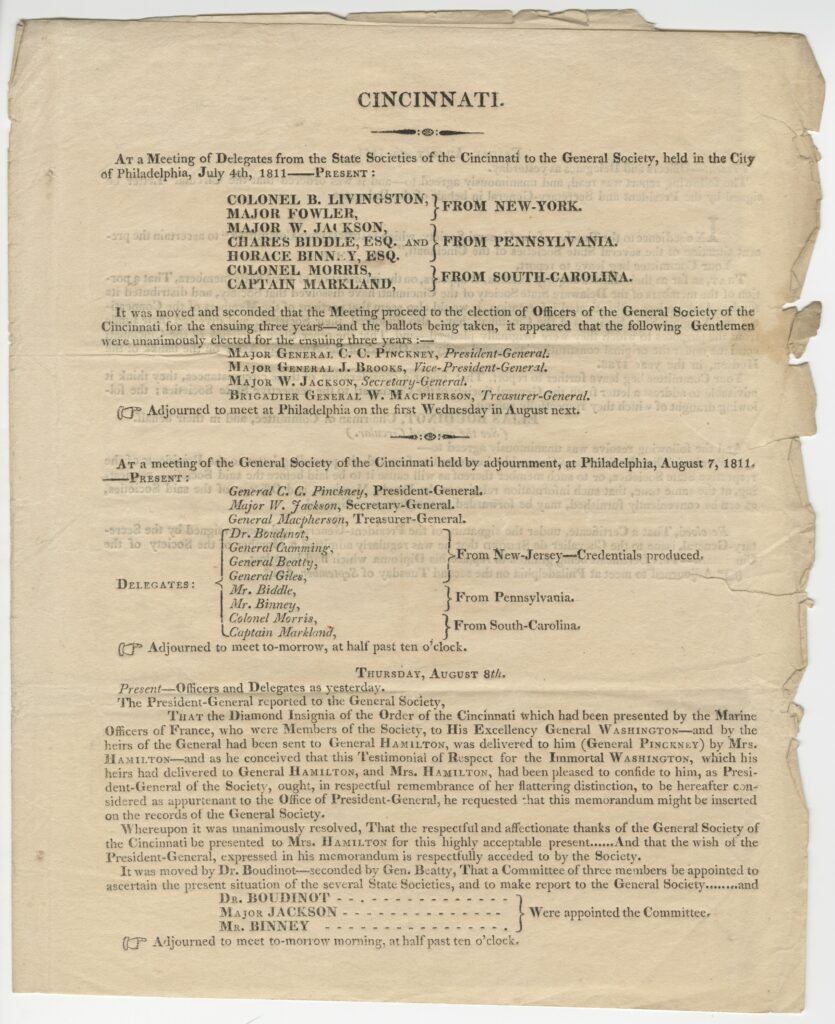
July 4, 1811
The Society of the Cincinnati Archives
This printed broadsheet details the Society’s 1811 general meetings, the first to be called by Charles Cotesworth Pinckney since he succeeded to the office of president general following Alexander Hamilton’s death in 1804. The notable business of their August 8 meeting was Pinckney’s report that he had received from Mrs. Hamilton “the Diamond Insignia of the Order of the Cincinnati which had been presented by the Marine Officers of France … to His Excellency General Washington, and by the heirs of the General had been sent to General Hamilton.” The Society responded with a resolution thanking Mrs. Hamilton for “this highly acceptable present” and affirming General Pinckney’s recommendation that the Diamond Eagle “be hereafter considered as appurtenant to the Office of President-General.”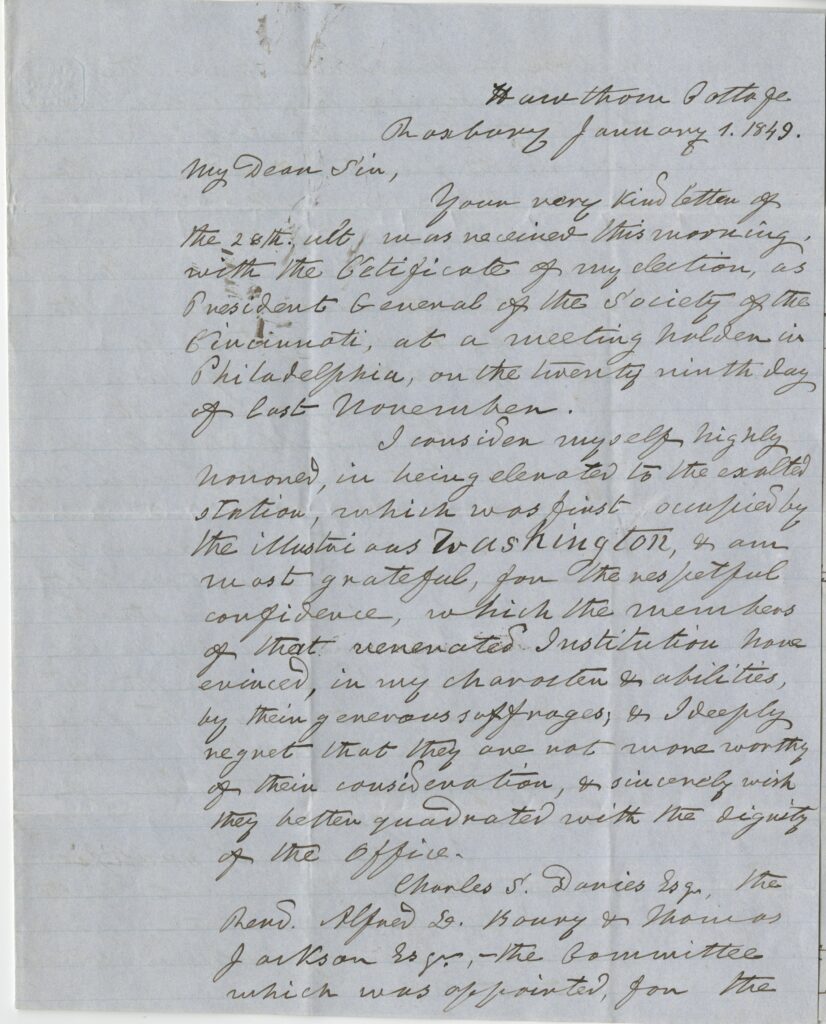
January 1, 1849
The Society of the Cincinnati Archives
When Henry Alexander Scammell Dearborn was elected the eighth president general of the Society of the Cincinnati in 1848, he became the first hereditary member to hold the office. In this letter to the Society’s secretary general, Dearborn wrote of the honor of receiving the Diamond Eagle, noting that the presentation had taken place on December 14, 1848, the forty-ninth anniversary of Washington’s death. “As a humble disciple of that Greatest and Best of Men, may I be ever emulous to imitate his preeminent virtues, & anxiously endeavor to maintain those lofty principles by which he was actuated … as one of the most decided & efficient advocates for the Rights and Liberties of his countrymen.”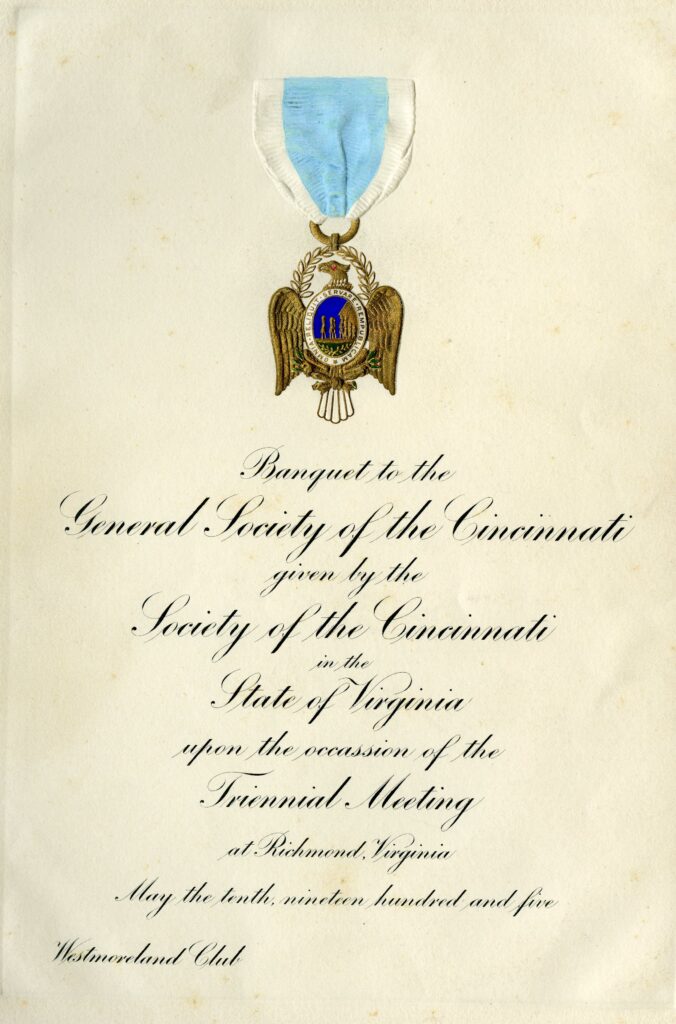
May 10, 1905
The Society of the Cincinnati Archives
Starting in 1851, the individual constituent societies in rotation took on the responsibility of organizing and hosting the Society’s Triennial Meetings. Through the late nineteenth and early twentieth centuries, the hosting societies produced souvenir programs, menus, and other printed ephemera of notable elegance and design. The program for the Triennial banquet hosted by the Virginia Society, held in Richmond on May 10, 1905, featured a gilded embossed Eagle.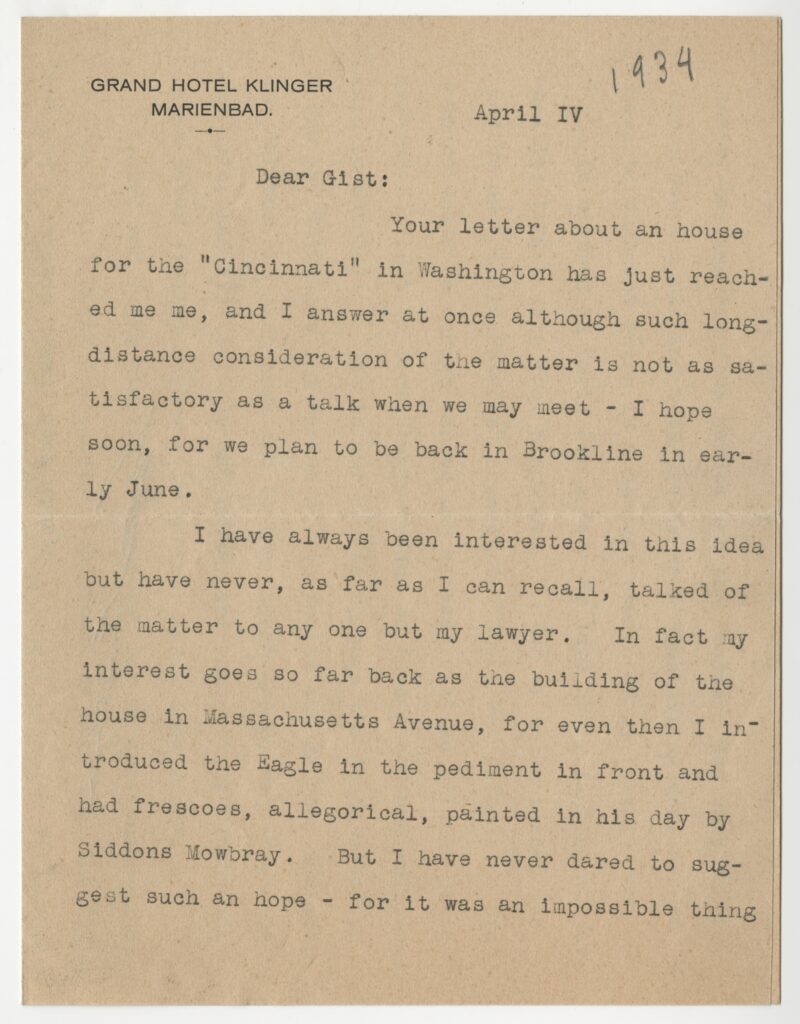
April 6, [1934]
The Society of the Cincinnati Archives
In this letter to his fellow Cincinnatus Gist Blair, Larz Anderson discussed his interest in the possibility of Anderson House becoming the headquarters of the Society of the Cincinnati: “[M]y interest goes so far back as the building of the house in Massachusetts Avenue, for even then I introduced the Eagle in the pediment in front and had frescoes, allegorical, painted in his day by Siddons Mowbray.” Explaining the uncertainties he and his wife were facing in “this changing age,” he concluded, “Time alone can tell what may be in a position to do.”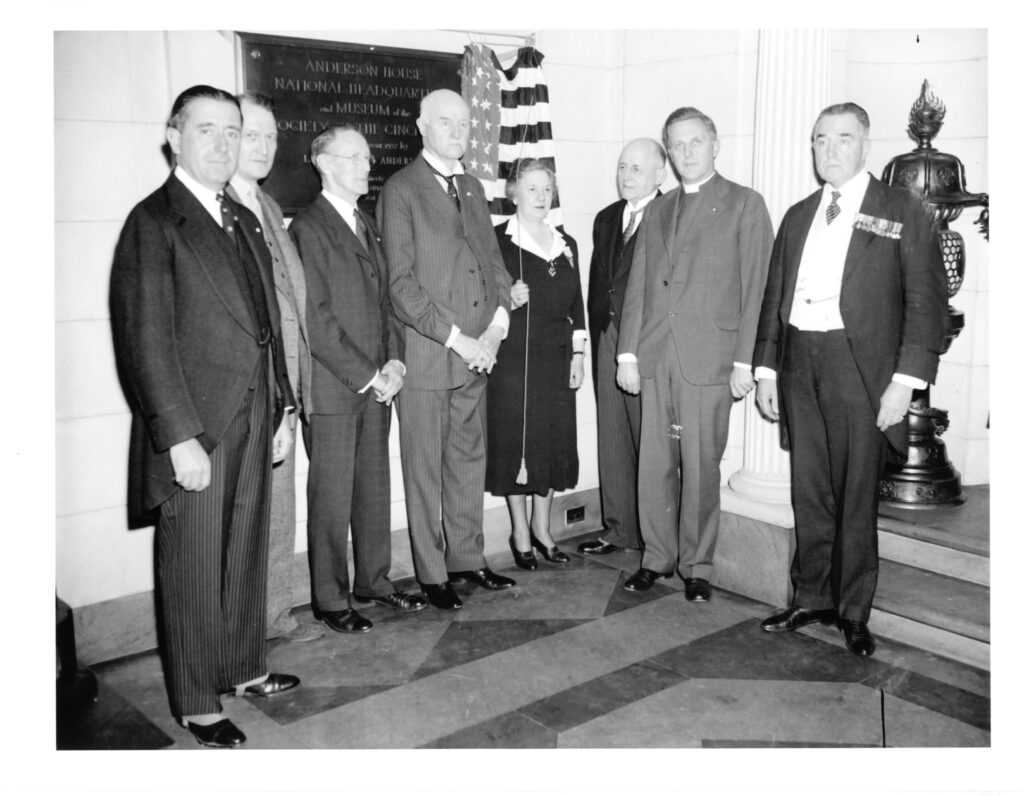
April 19, 1939
The Society of the Cincinnati Archives
This photograph documents the ceremonial unveiling of a bronze plaque in the Entrance Hall of Anderson House marking Isabel Anderson’s gift of the house to the Society to be its first national headquarters. From left to right: Robert Copeland Jones, Lt. Col. Edgar Erskine Hume, Francis Althorp Foster, Gist Blair, Mrs. Anderson, Bryce Metcalf, George B. Kinkead, and John Phillip Hill.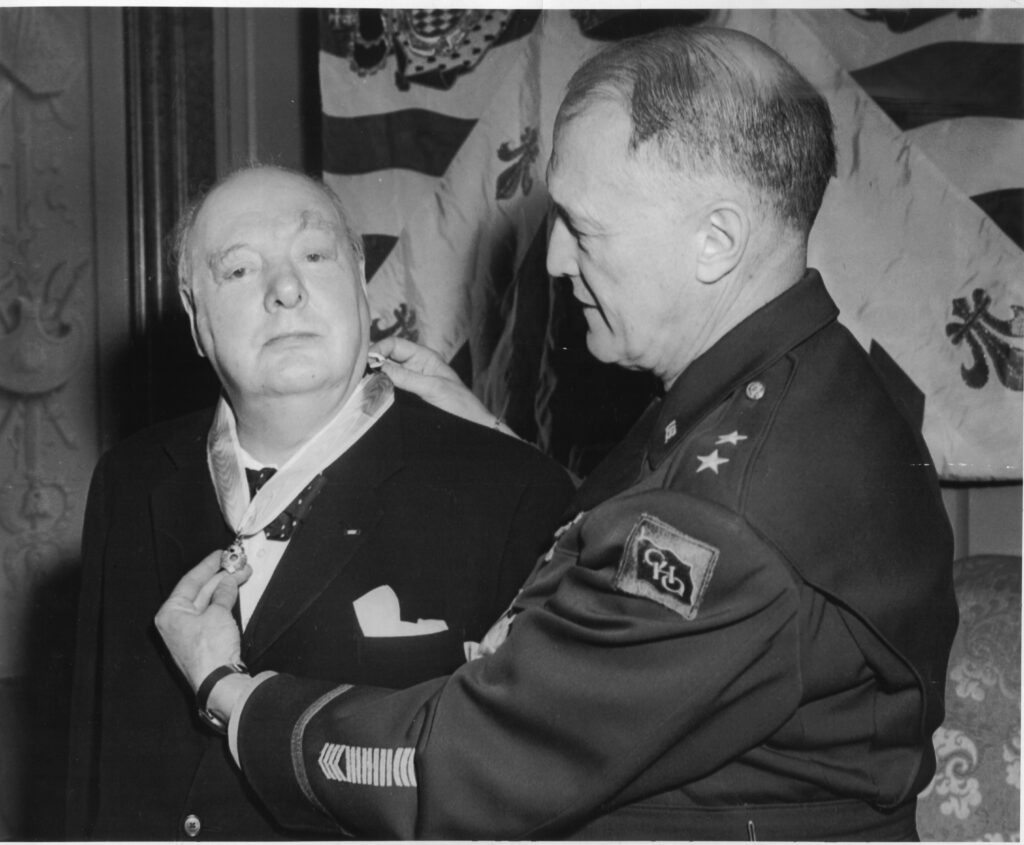
January 16, 1952
The Society of the Cincinnati Archives, Gift of the U.S. Army Office of Information, 1952
Sir Winston Churchill was admitted to hereditary membership in the Connecticut branch of the Society in 1947, representing the line of Lt. Reuben Murray, a Revolutionary War officer from whom he was descended on his maternal side. While on an official visit to the United States in 1950, the British prime minister received his Society Eagle in a ceremony in the Anderson House Ballroom. A portion of Churchill’s remarks that afternoon were captured on a Fox Movietone News clip: “I thank you from the bottom of my heart for the kindness which you have shown me. I value this honor, and let it be a help to all of those forces—they are, in my opinion, irresistible forces—which draw our two nations together; not for any unworthy purpose of combination or gathering strength, but in order that we may defend the freedom of the world.”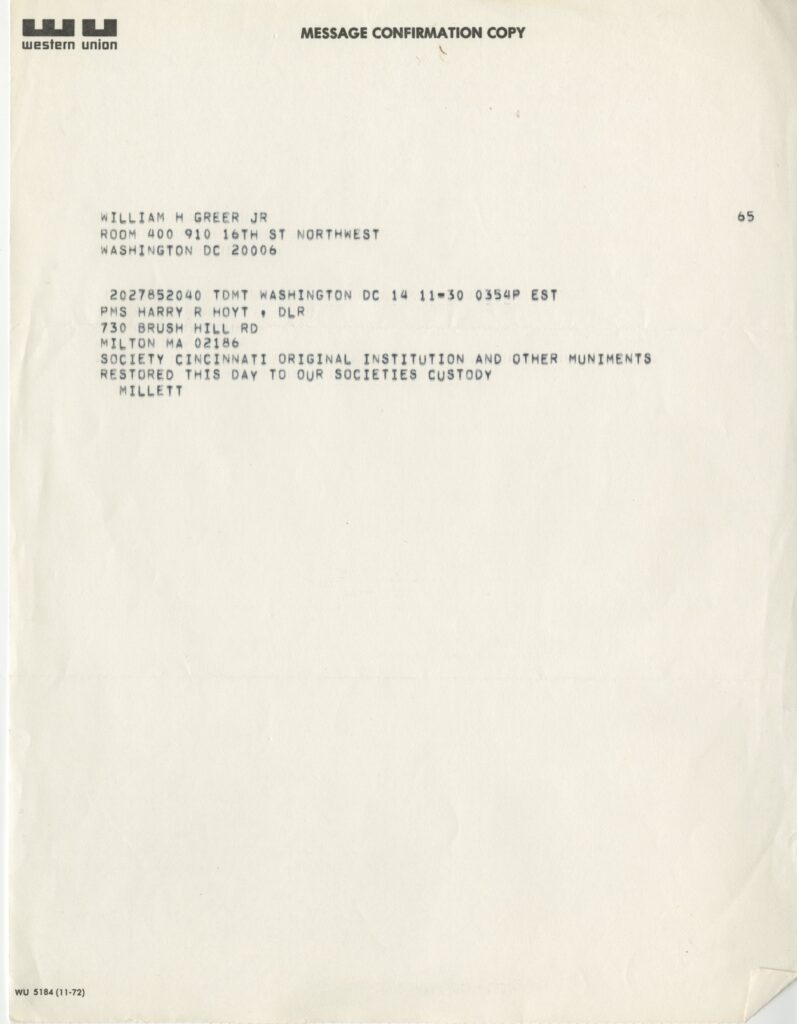
November 30, 1973
The Society of the Cincinnati Archives
The Society of the Cincinnati archival collection, which had been on deposit for safekeeping at the Library of Congress since the 1930s, was returned to the Society’s custody on November 30, 1973. This telegram, sent by the chairman of the Museum Committee on behalf of Secretary General Stephen Caldwell Millett informed Vice President General Harry Ramsay Hoyt that mission was accomplished.